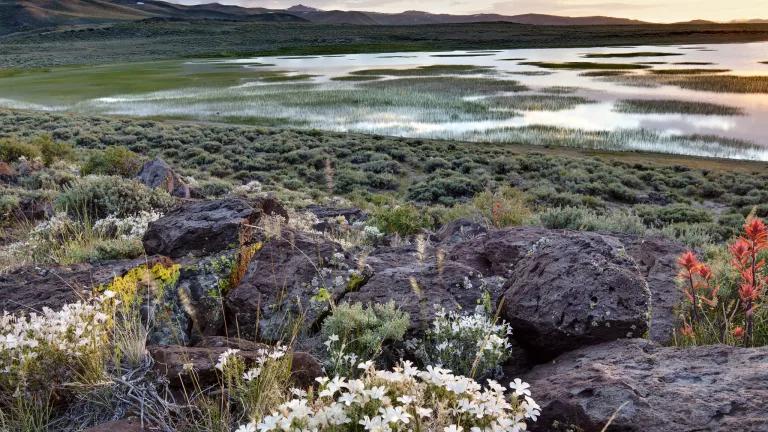Saving Laguna San Ignacio: 20 Years and Counting

The defeat in March 2000 of Mitsubishi’s proposal to industrialize the last undisturbed breeding and calving lagoon of the Pacific gray whale remains one of the great environmental successes in history.
On March 2, 2000, twenty years ago this week, then-President Ernesto Zedillo of Mexico held a press conference in Mexico City to announce the abandonment of a proposal to build the world’s largest industrial salt factory, around the pristine waters of Laguna San Ignacio, on the remote Pacific Coast of Baja California. As a result, and as I saw this week during my latest visit to the lagoon, this perfect natural gem—this invaluable natural ecosystem—remains perfect today.
It’s a UNESCO World Heritage Site, a United Nations Biosphere Reserve, a whale sanctuary, a migratory bird sanctuary, and the last place on Earth where gray whales can breed and calve undisturbed by human intrusion. And if these multiple levels of formal recognition aren’t unique enough, Laguna San Ignacio is also world-renowned as the home of the friendly gray whale, where 45-feet long, 40-ton mothers and their calves regularly approach whale-watchers to be touched and even kissed—by the descendants of the hunters that not long ago nearly exterminated the gray whale species.

This last remaining pristine gray whale lagoon was the wrong place for 116 square miles of industrial development—an area over twice the size of San Francisco. But that’s exactly what Mitsubishi Corporation and the Mexican government had in mind when in 1994 their joint venture—called Esportadora de Sal (“ESSA”)—proposed construction of a salt factory to produce seven million tons of industrial salt each year, to be used in the manufacture of chemicals and PVC pipe in Japan.
Once discovered, this reckless plan became the focus of one of the largest and most successful international place-based environmental campaigns in history.

Spearheaded by Mexican poet, diplomat, and environmentalist Homero Aridjis and his Mexico City-based organization El Grupo de los Cien—or Group of 100—this campaign ultimately comprised an unprecedented coalition of some 35 environmental groups in Mexico, attracting world-wide attention through the assistance of the Natural Resources Defense Council (“NRDC”), the International Fund for Animal Welfare (“IFAW”), and a host of international celebrities.

Pierce and Keely Brosnan, Glenn Close, Jean-Michel Cousteau, Robert F. Kennedy, Jr., renowned whale scientist Dr. Roger Payne, landscape photographer and conservationist Robert Glenn Ketchum, and many others joined the fight, giving interviews, appearing at press events, and even joining week-long trips to the remote lagoon to introduce major television, film, and media organizations to the special natural values of the region and the existential threat to them posed by the Mitsubishi project.
This was a proposal that, in 1994, appeared unstoppable given the immense resources and global power of Mitsubishi—one of the largest multi-national corporations on Earth—with Mexico as its joint venture partner. But over the course of the campaign the international coalition adopted a range of tactics to elevate the battle and exert pressure on both, including, for example:

- raising public awareness in Mexico and globally through a range of communications strategies,
- petitioning the World Heritage Committee of UNESCO to list Laguna San Ignacio as a World Heritage Site in Danger,
- activating NRDC’s members and activists to generate over a million letters of opposition to Mitsubishi, Mexico, and the World Heritage Committee,
- recruiting the world’s best-known scientists across a wide range of disciplines (including nine Nobel Laureates) to oppose the project,
- retaining top Mexican diplomats and lawyers to manage and implement the campaign in Mexico
- advocating inside the legislative and administrative agencies of the Mexican government,
- securing resolutions condemning the project from city, county and state agencies along the Pacific Coast of California (including the California Coastal Commission),
- undertaking an economic boycott in California against Mitsubishi-affiliated companies like Mitsubishi Motors, Mitsubishi Electronics, and Mitsubishi’s United California Bank,
- recruiting mutual funds and fund managers to publicly state that they did not consider Mitsubishi a sound environmental investment, and
- successfully educating and engaging the people and communities around Laguna San Ignacio on the risks of the salt works project to their fisheries, economic livelihood, and way of life.

Ultimately, the decision twenty years ago to protect Laguna San Ignacio and cancel the salt works project was driven by and rested with the people of Mexico themselves and their governmental leaders. Over the course of the intense international campaign, however, it had become increasingly clear to all concerned that the demand for protection of the lagoon and the opposition to its industrialization were only going to grow—inside Mexico and around the world.
This is a truly extraordinary example of international cooperation, but the story doesn’t end there.
In 2005, the Laguna San Ignacio Conservation Alliance was formed to secure enhanced permanent protection for key lands around the lagoon and ensure the salt works project could never return. As part of this effort, NRDC and its Alliance partners have thus far secured conservation easements on 140,850 acres of ejido and private properties on the east side of the lagoon, and the Mexican government has granted to Pronatura Noroeste a conservation concession for 199,040 acres of federal lands on the west side of the lagoon. WILDCOAST, another Alliance partner, has secured concessions to protect 150 miles of pristine beach and mangrove areas around the lagoon.

Over $2 million have been raised to protect the lagoon, creating (1) a conservation trust fund that provides annual payments for sustainable community development projects in the region and (2) an endowment that supports on-the-ground monitoring and management activities of the conservation concession.
If these ongoing collective efforts can continue, we will together have secured not only the permanent protection of this natural gem but a sustainable economic future for the communities around the lagoon that depend on it.





